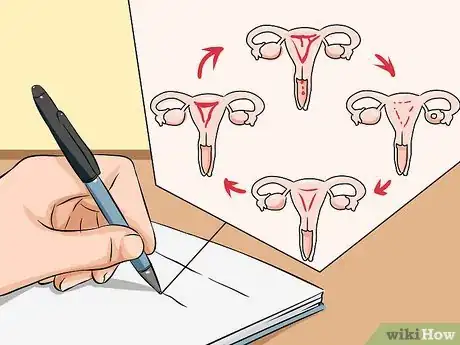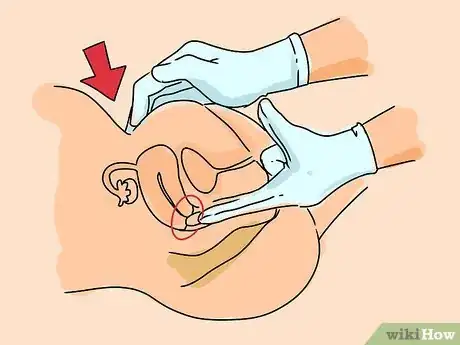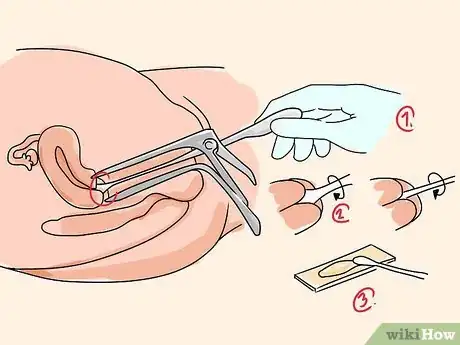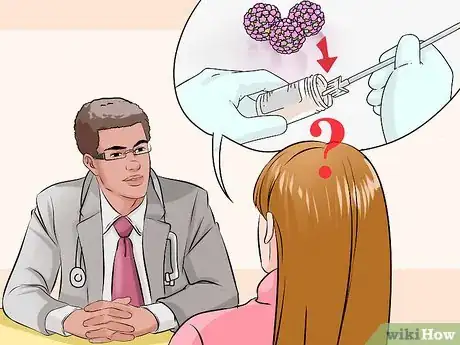This article was medically reviewed by Lacy Windham, MD. Lacy Windham, MD, is a Board-Certified Obstetrician & Gynecologist in Cleveland, Tennessee. Dr. Windham attended medical school at the University of Tennessee Health Science Center in Memphis. Her residency was completed at Eastern Virginia Medical School in Norfolk, Virginia. She was the recipient of multiple awards during her residency training, including Most Outstanding Resident in Maternal Fetal Medicine, Most Outstanding Resident in Oncology, Most Outstanding Resident Overall, and Special Award in Minimally Invasive Surgery.
There are 22 references cited in this article, which can be found at the bottom of the page.
wikiHow marks an article as reader-approved once it receives enough positive feedback. In this case, 100% of readers who voted found the article helpful, earning it our reader-approved status.
This article has been viewed 161,978 times.
Experts agree that cervical cancer is highly treatable if you catch it early, so it's important to get wellness exams.[1] Cervical cancer affects your cervix, which is the lower part of your uterus where it connects with your vagina. The most common cause of cervical cancer is the human papillomavirus (HPV), so it's highly preventable. Studies show that cervical cancer typically causes no symptoms at first, but you may develop bleeding after intercourse, pelvic pain, pain during intercourse, or watery, bloody discharge.[2] Try not to worry if you suspect you have cervical cancer, but see your doctor right away so you can get treatment.
Steps
Knowing the Symptoms
-
1Keep a good record of your menstrual periods. If you are premenopausal or perimenopausal, use a calendar to keep track of when your menstrual period will come and how long it will last. If you are menopausal, know when your last period was. A major symptom of cervical cancer is abnormal vaginal bleeding. It is good to know what is normal for you and other women like you.[3]
- You will usually have regular menstrual cycles if you are premenopausal. Each woman is different, but a normal cycle will be 28 days, plus or minus 7 days.[4]
- You will have irregular menstrual periods if you are peri-menopausal. This phase normally starts between the ages of 40 and 50. This transition occurs when your ovaries gradually begin to produce less estrogen. It can last anywhere from several months to 10 years before menopause is fully reached.[5]
- You will no longer have menstrual periods if you are menopausal. Your hormone levels have reached a point where you no longer ovulate or release eggs. You can no longer become pregnant.[6]
- You will not have menstrual periods if you have had a hysterectomy. You no longer have a uterus and you will no longer shed the lining of your uterus. You should not be bleeding. If you still have ovaries that work, you are not menopausal.[7]
-
2Look for spotting in between your menstrual periods.[8] When you have spotting, there is much less bleeding and the blood may have a different color than your normal menstrual flow.
- It is normal for a premenopausal woman to have an irregular cycle, occasionally. Spotting could be seen. Many factors like illness, stress or strenuous exercise can interfere with your cycle. Seek medical attention if your menstrual period remains irregular for several months.[9]
- Spotting could be a normal part of your peri-menopausal phase. Be vigilant and look for other symptoms of cervical cancer.[10]
Advertisement -
3
-
4Call your doctor if you unexpectedly start having your menstrual period again. Just remember that no amount of vaginal bleeding is normal if you are menopausal or if you have had a hysterectomy.[13]
- Do not assume your cervix has been removed because you have had a hysterectomy. Your entire uterus, including your cervix, is removed during a total hysterectomy. A supracervical hysterectomy is often performed for non-cancerous conditions. Your cervix is left in place and you can develop cervical cancer. Ask your gynecologist which type you have undergone.[14]
- Consider yourself menopausal if you completely stopped having menstrual periods for 12 straight months.[15]
-
5Look for vaginal bleeding after normal activities. These activities include vaginal sexual intercourse, douching, and even a pelvic exam by a doctor. Talk to your doctor about the nature of the bleeding, spotting versus a heavy flow.[16]
- When a doctor performs a pelvic exam, she inserts two gloved fingers into your vagina while her other hand presses on your lower abdomen. She can examine your uterus, including your cervix, and ovaries looking for signs of problems or disease. It should not cause heavy bleeding.[17]
-
6Take note of any unusual vaginal discharge. The discharge may be bloody and it occurs in between menstrual periods. It could be foul-smelling, as well.[18]
- The cervix produces mucus that changes in consistency during the menstrual cycle to either prevent or promote pregnancy.[19] It should not be bloody in between periods.
- Menstrual blood may accumulate in the vagina and smell foul if it is left there for a long time, especially more than 6 to 8 hours. This is different from a discharge smelling bad.[20]
- Seek medical treatment. Discharge that is foul smelling could be caused by other conditions like infection which can cause pain and bleeding, or by precancerous lesions or cancer.[21]
-
7Tell your doctor about pain after sex or new pelvic pain.[22] Pain during sex may be normal; 3 out of 4 women have had pain during intercourse at some point. However, if it occurs frequently or is very severe, talk to a qualified medical professional about painful sex.[23] [24] Differentiate between your standard menstrual cramps and pain in your pelvis or lower abdomen.
- Menopausal and peri-menopausal women can develop changes in their vaginal walls because of dropping estrogen levels. Vaginal walls become thinner, dryer, less elastic, and may become irritated (atrophic vaginitis). Sometimes sex becomes painful due to these vaginal changes. [25]
- Sex may also be painful if you have certain skin conditions or are having sexual response difficulties.[26]
Seeking Medical Attention
-
1Make an appointment with a doctor as soon as your symptoms appear. A delay could lead to more advanced disease and lower your chances of obtaining a cure.[27] [28]
- Your doctor will talk to you about your personal and family history as well as your symptoms. She will talk about risk factors such as having many sexual partners, early sexual activity, being diagnosed with other sexually transmitted diseases, signs of a weak immune system, and a history of smoking.[29] [30]
- Your doctor will perform a perform a physical examination to determine your general state of health. She will perform a Pap smear and HPV test if they have not previously been performed. These are screening tests (looking for signs of cervical cancer) and not diagnostic (confirming the presence of cervical cancer).[31]
- Diagnostic studies are performed when you have an abnormal Pap smear and/or symptoms consistent with cervical cancer. A colposcopy is performed; this instrument, which opens the vagina like a speculum, also magnifies the cervix so that your doctor can visualize any abnormal areas on the cervix. Scrapings of the endocervix (the part closest to the uterus)[32] and/or cone-shaped biopsies will be taken. A pathologist looks under the microscope to make the diagnosis of pre-cancerous or cancerous changes in the cells.[33]
-
2
-
3Get a regular Pap smear. The Pap smear, or Pap test, identifies pre-cancerous cells that could become cervical cancer if they are not treated early and appropriately.[36] The Pap smear is recommended for all women between the ages of 21 and 65 years old. It can be performed in the doctor’s office or in a medical clinic.
- A speculum, an instrument used to widen the vagina, will be inserted by the gynecologist. As the doctor examines the vagina and cervix, cells and mucus are collected from the cervix and the surrounding tissue. These samples are placed on a slide or in a bottle of liquid and sent to a laboratory. They will be checked under a microscope, looking for abnormalities.[37]
- You should get a regular Pap smear even if you are not currently sexually active and even if you have gone through menopause.[38]
- In the US, Pap smears are covered under the Affordable Care Act, so most insurance plans must cover them at no cost. If you don't have insurance, you may be able to find a free or low-cost test from a local community health clinic.[39]
-
4Get an HPV test. This test looks for the virus, human papillomavirus, that can cause pre-cancerous cell changes in the cervix.[40] Most cervical cancers are caused by HPV infection. The HPV virus is passed from person to person during sexual intercourse.[41] The cells collected during the Pap smear can be tested for HPV as well.[42]
- The cervix is the cylinder neck-like passage at the lower end of the uterus.[43] The ectocervix is the part of the cervix the doctor sees during the speculum exam.[44] The endocervix is the tunnel through the cervix into the uterus. The transformation zone is the overlapping border between the endocervix and the ectocervix. This is where most cervical cancers develop. Samples of the cervical cells and mucus are taken from here.[45]
- If you are 30 or older, you can usually have a Pap smear and HPV test together every 5 years.[46]
-
5Talk with your doctor about how often you should have a Pap smear and HPV test. The frequency at which you are screened or need follow-up is based upon factors like your age, your sexual history, your previous history of an abnormal Pap smear, and your previous history of HPV infection.[47]
- Most women between 21-29 should get a Pap smear every 3 years. Women between 30-64 should get a Pap smear every 3 years, or a Pap smear + HPV test every 5 years.[48]
- If you have a weakened immune system, you are HIV-positive, or have ever had abnormal Pap results, you should ask your doctor whether you need a Pap smear more frequently.[49]
- Cervical cancer is one of the most common in women worldwide, but is much less common in countries like the United States where cervical cancer screening, Pap smear and HPV testing, is routine.[50]
- Get your diagnosis and treatment early. Pre-cancerous cervical cells with more severe changes are at a greater the risk of changing into cancerous cells. This transformation from normal to abnormal to invasive cancer can happen over a period as long as 10 years, but it could happen sooner.[51]
Expert Q&A
-
QuestionDrinking cold water can make the risk higher?
 Carrie Noriega, MDDr. Noriega is a Board Certified Obstetrician & Gynecologist and medical writer in Colorado. She specializes in women’s health, rheumatology, pulmonology, infectious disease, and gastroenterology. She received her MD from the Creighton School of Medicine in Omaha, Nebraska and completed her residency at the University of Missouri - Kansas City in 2005.
Carrie Noriega, MDDr. Noriega is a Board Certified Obstetrician & Gynecologist and medical writer in Colorado. She specializes in women’s health, rheumatology, pulmonology, infectious disease, and gastroenterology. She received her MD from the Creighton School of Medicine in Omaha, Nebraska and completed her residency at the University of Missouri - Kansas City in 2005.
Board Certified Obstetrician & Gynecologist No, drinking cold water is not a risk factor for uterine cancer.
No, drinking cold water is not a risk factor for uterine cancer.
References
- ↑ https://www.cdc.gov/cancer/cervical/basic_info/index.htm
- ↑ https://www.mayoclinic.org/diseases-conditions/cervical-cancer/symptoms-causes/syc-20352501
- ↑ http://www.cancer.org/cancer/cervicalcancer/moreinformation/cervicalcancerpreventionandearlydetection/cervical-cancer-prevention-and-early-detection-cervical-cancer-signs-and-symptoms
- ↑ http://www.everydayhealth.com/pms/irregular-periods.aspx
- ↑ http://www.healthline.com/health/menopause/difference-perimenopause
- ↑ http://www.healthline.com/health/menopause/difference-perimenopause
- ↑ http://www.mayoclinic.org/tests-procedures/vaginal-hysterectomy/basics/what-you-can-expect/prc-20020565
- ↑ http://www.cancer.org/cancer/cervicalcancer/moreinformation/cervicalcancerpreventionandearlydetection/cervical-cancer-prevention-and-early-detection-cervical-cancer-signs-and-symptoms
- ↑ http://www.everydayhealth.com/pms/irregular-periods.aspx
- ↑ http://www.healthline.com/health/menopause/difference-perimenopause
- ↑ http://www.cancer.org/cancer/cervicalcancer/moreinformation/cervicalcancerpreventionandearlydetection/cervical-cancer-prevention-and-early-detection-cervical-cancer-signs-and-symptoms
- ↑ http://www.menstruation-info-with-doc.com/menstruation-blood.html
- ↑ http://www.cancer.org/cancer/cervicalcancer/moreinformation/cervicalcancerpreventionandearlydetection/cervical-cancer-prevention-and-early-detection-cervical-cancer-signs-and-symptoms
- ↑ http://womenshealth.gov/publications/our-publications/fact-sheet/hysterectomy.html
- ↑ http://www.healthline.com/health/menopause/difference-perimenopause
- ↑ http://www.cancer.org/cancer/cervicalcancer/moreinformation/cervicalcancerpreventionandearlydetection/cervical-cancer-prevention-and-early-detection-cervical-cancer-signs-and-symptoms
- ↑ http://www.cdc.gov/cancer/cervical/basic_info/screening.htm
- ↑ http://www.cancer.org/cancer/cervicalcancer/moreinformation/cervicalcancerpreventionandearlydetection/cervical-cancer-prevention-and-early-detection-cervical-cancer-signs-and-symptoms
- ↑ https://www.jostrust.org.uk/about-us/news-and-blog/blog/things-you-didnt-know-about-your-cervix
- ↑ http://www.menstruation-info-with-doc.com/menstruation-blood.html
- ↑ http://www.cancer.org/cancer/cervicalcancer/moreinformation/cervicalcancerpreventionandearlydetection/cervical-cancer-prevention-and-early-detection-cervical-cancer-signs-and-symptoms
- ↑ http://www.cancer.org/cancer/cervicalcancer/moreinformation/cervicalcancerpreventionandearlydetection/cervical-cancer-prevention-and-early-detection-cervical-cancer-signs-and-symptoms
- ↑ http://www.acog.org/Patients/FAQs/When-Sex-Is-Painful
- ↑ http://www.nlm.nih.gov/medlineplus/ency/article/004016.htm
- ↑ http://www.nlm.nih.gov/medlineplus/ency/article/004016.htm
- ↑ http://www.acog.org/Patients/FAQs/When-Sex-Is-Painful
- ↑ http://www.cancer.org/cancer/cervicalcancer/moreinformation/cervicalcancerpreventionandearlydetection/cervical-cancer-prevention-and-early-detection-cervical-cancer-signs-and-symptoms
- ↑ http://www.cancer.net/cancer-types/cervical-cancer/symptoms-and-signs
- ↑ https://www.mayoclinic.org/diseases-conditions/cervical-cancer/symptoms-causes/syc-20352501
- ↑ http://www.cancer.org/cancer/cervicalcancer/detailedguide/cervical-cancer-diagnosis
- ↑ http://www.cancer.org/cancer/cervicalcancer/detailedguide/cervical-cancer-diagnosis
- ↑ http://www.cancer.org/cancer/cervicalcancer/detailedguide/cervical-cancer-what-is-cervical-cancer
- ↑ http://www.cancer.org/cancer/cervicalcancer/detailedguide/cervical-cancer-diagnosis
- ↑ http://www.cancer.org/cancer/cervicalcancer/moreinformation/cervicalcancerpreventionandearlydetection/cervical-cancer-prevention-and-early-detection-cervical-cancer-signs-and-symptoms
- ↑ http://www.cancer.org/cancer/cervicalcancer/detailedguide/cervical-cancer-prevention
- ↑ http://www.cdc.gov/cancer/cervical/basic_info/screening.htm
- ↑ http://www.cdc.gov/cancer/cervical/basic_info/screening.htm
- ↑ http://www.womenshealth.gov/publications/our-publications/fact-sheet/pap-test.html
- ↑ http://www.womenshealth.gov/publications/our-publications/fact-sheet/pap-test.html
- ↑ http://www.cdc.gov/cancer/cervical/basic_info/screening.htm
- ↑ http://www.cdc.gov/cancer/cervical/pdf/cervical_facts.pdf
- ↑ http://www.cdc.gov/cancer/cervical/basic_info/screening.htm
- ↑ http://www.cancer.org/cancer/cervicalcancer/detailedguide/cervical-cancer-what-is-cervical-cancer
- ↑ http://www.cancer.org/cancer/cervicalcancer/detailedguide/cervical-cancer-what-is-cervical-cancer
- ↑ http://www.sahealth.sa.gov.au/wps/wcm/connect/public+content/sa+health+internet/healthy+living/recommended+health+checks/pap+smears/pap+smear+results+what+do+they+mean
- ↑ http://www.womenshealth.gov/screening-tests-and-vaccines/screening-tests-for-women/index.html
- ↑ http://www.cdc.gov/cancer/cervical/pdf/cervical_facts.pdf
- ↑ http://www.womenshealth.gov/publications/our-publications/fact-sheet/pap-test.html
- ↑ http://www.womenshealth.gov/publications/our-publications/fact-sheet/pap-test.html
- ↑ http://www.cancer.org/cancer/cervicalcancer/detailedguide/cervical-cancer-key-statistics
- ↑ https://www.cancer.ca/en/cancer-information/cancer-type/cervical/cervical-cancer/precancerous-conditions/?region=bc
About This Article
Cervical cancer can occur at any age, but it’s most common in women between the ages of 20 and 50. It’s not unusual if you occasionally have an irregular menstrual cycle, but if it remains irregular for several months, this could be a sign of cervical cancer. For instance, you might have spotting in between your periods or have longer and heavier periods than usual. Keep a record of your periods to help you notice any irregularities. Another symptom of cervical cancer is frequent pain during sex. If you notice any of these symptoms, make an appointment with your doctor. Fortunately, cervical cancer is very curable when treated early on. For more tips from our Medical co-author, including how cervical cancer is usually treated, read on.












-Step-13.webp)







-Step-8-Version-3.webp)














-Step-13.webp)






































Medical Disclaimer
The content of this article is not intended to be a substitute for professional medical advice, examination, diagnosis, or treatment. You should always contact your doctor or other qualified healthcare professional before starting, changing, or stopping any kind of health treatment.
Read More...